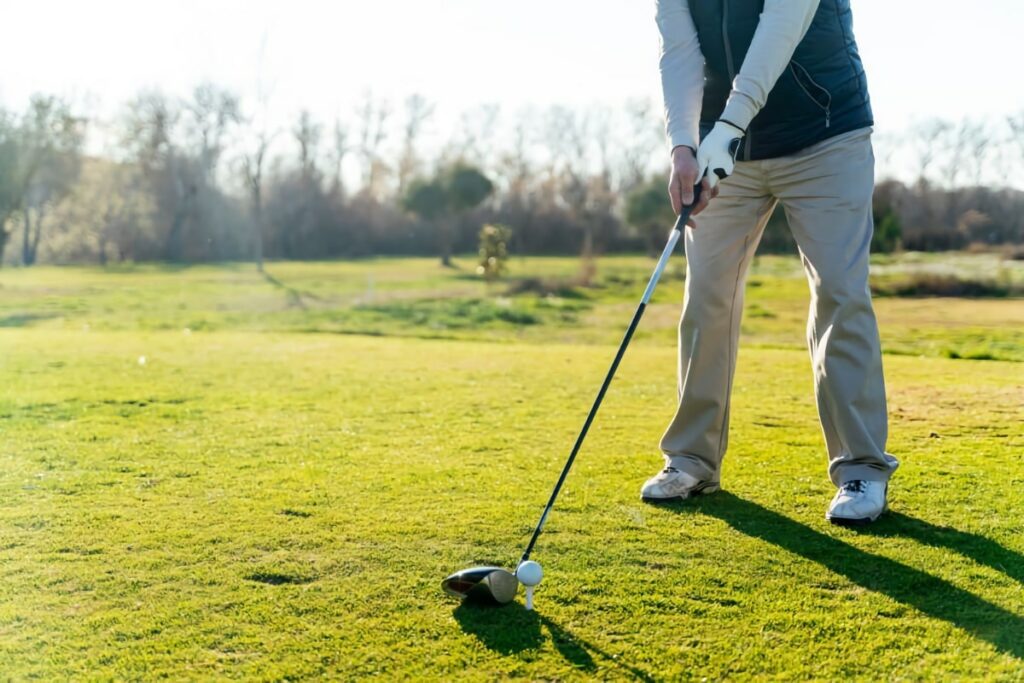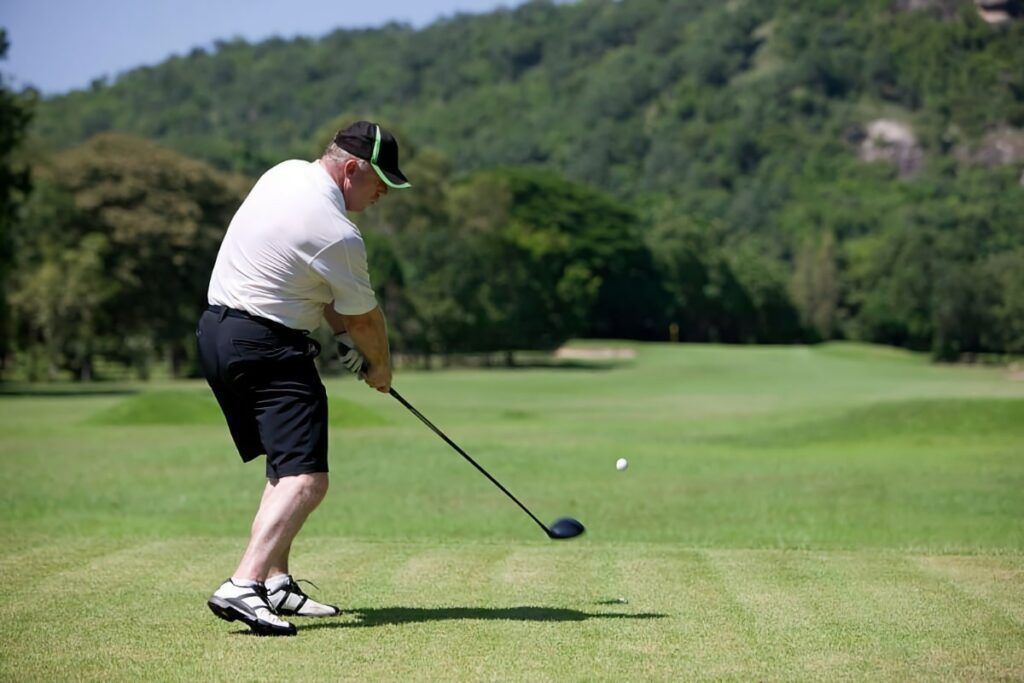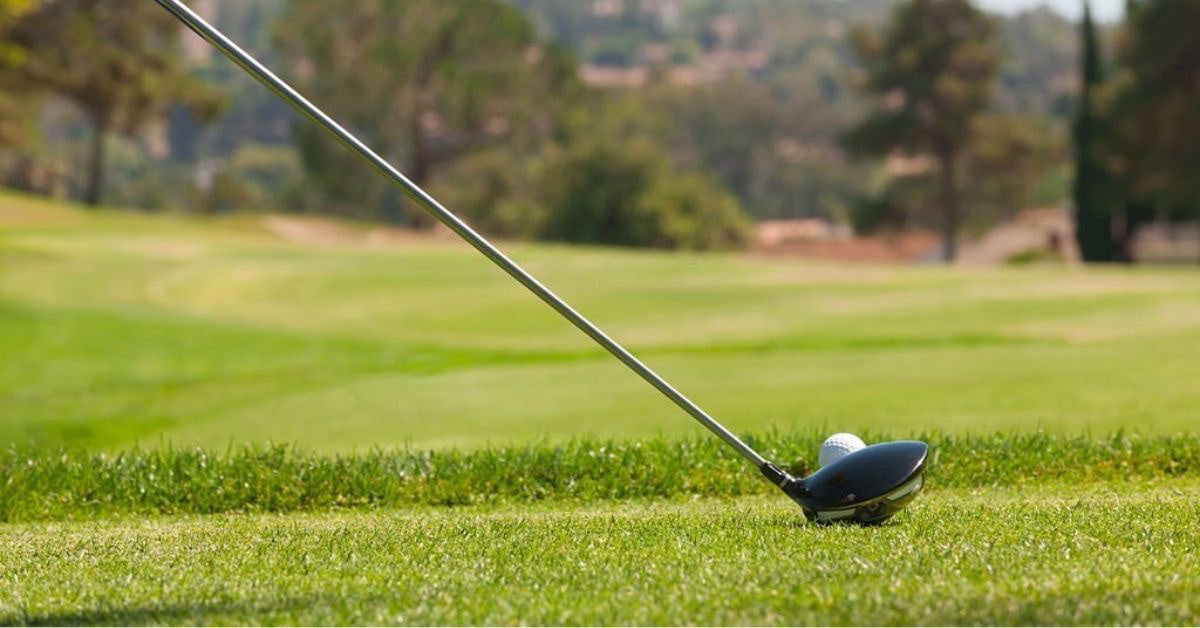The heel shot is one of golf’s most frustrating shots.
Picture the scene. You set up to bomb your tee shot down the fairway, but the result is a low-flying and weak drive that barely travels any distance.
Fortunately, it only takes a few tweaks to start finding the center of the face!
In this article, I’ll teach you how to avoid hitting driver off the heel. With these simple tips, you can start regaining accuracy and distance off the tee.
Let’s get into it!
Why Am I Hitting Driver Off the Heel?
Hitting driver off the heel is often caused by an incorrect address position that leads to a faulty impact position. The heel shot comes from standing too close to the ball, not extending the arms at address, too much weight on the toes, or improper weight transfer throughout the swing.
Next, we’ll dive into the causes and fixes of the dreaded heel shot. Read on!

How to Avoid Hitting Driver Off the Heel
Whenever I help golfers who are struggling with heel hits with their driver, it’s one of the more satisfying swing fixes to make.
Why? Because it only takes a few subtle adjustments!
As a result, players are always so relieved to find the center of the clubface again.
So, here’s how to go about avoiding hitting the driver off the heel:
Step 1: Check Your Distance to the Ball
In my experience, the primary reason why golfers hit a heel shot with their driver is because they are standing too close to the ball at address.
While you might have the center of the face lined up with the ball in your setup, standing too close to the ball will expose the heel of the face at impact.
Essentially, this happens because your arms extend in the downswing. As a result, the club head shifts further from your body, and you end up striking the heel.
To prevent this, have plenty of distance between yourself and the golf ball. Your arms should hang naturally below your shoulders, without any elbow bend.
PGA Pro Alex Elliott says: “The sole of the club should naturally sit on the ground now and your arms should be hanging straight down from your shoulders.”
Remember, the driver is the longest club in the bag — give yourself space!
Step 2: Check Your Weight Distribution
Sometimes, heel shots are caused by too much weight on your toes at setup.
As you swing through the ball, your weight continues to shift forward. As a result, you move the head of the club forward and miss the center of the face.
Your weight at setup should be spread about 50/50 between your feet. It should also be through the center of your feet, rather than your heels or toes.
That way, you can maintain a stable base throughout the swing — giving yourself the best chance of finding the center of the face rather than the heel.
Step 3: Analyze Your Extension
Lack of arm extension through impact can result in hitting driver off the heel.
When you hold off from extending your arms through impact, your impact point on the clubface gets thrown off as you travel through the impact zone.
In short, extending your arms through impact is a good thing! If you want to get a proper swing plane and maximize distance — you need extension.
The solution is simple: make sure your arms are not weak, bent, or floppy when you set up to hit your tee shot with the driver.
Look at any professional golfer and the way their arms are outstretched. They aren’t reaching for the ball, but there is certainly some stability there.
Step 4: Understand Weight Transfer
If your first move from the top is to throw your arms at the golf ball, your weight will move toward your toes, and you will likely hit a heel shot.
Generally, this happens when golfers forget to rotate their lower body. Instead, they attack the ball with their upper body and arms, which exposes the heel.
Rather, you should ensure you are incorporating a solid lower body rotation into your swing. That way, your weight will naturally transfer in the downswing.
Check out the video below for some handy advice on fixing heel shots:
Practice Drills to Find the Center of the Face
So, we’ve covered the main causes of hitting the driver off the heel — along with practical fixes to help avoid it and unlock the sweet spot.
Here are a few useful practice drills I recommend you test out to help you locate the center of the clubface consistently:
- Video Your Setup: Capture some videos of your driver swing setup. Check to make sure you’re not standing too far away from the ball, and that you have plenty of extension through the ball at impact.
- Hit Wedges to Practice Footwork: Take out a pitching wedge and hit some half-swing shots where you feel your weight shift while staying centered on your feet. You’ll begin to notice cleaner contact and more consistency. Once you nail your wedges, switch to longer clubs like the driver.
- Experiment With Ball Position: I like having the ball lined up directly with the center of my clubface. However, some players find that putting the ball slightly towards the toe is a better fit for their game. Practice at the range, and see what suits your eye and fits your natural posture.

Equipment Considerations
As with any issue in your golf game, it’s important to consider the role of equipment and how it factors into your performance on the course.
In this scenario, your driver can sometimes be the cause of your heel hits.
Specifically, the main thing to look out for is the length of the driver. If you make adjustments in your setup because the length isn’t right, it can lead to heel hits.
Most often, if your driver shaft is too long for your height and natural posture, then you might be prone to striking the heel of the club off the tee.
If you’re not sure if your driver is the right length, I highly recommend taking a professional club fitting. That way, you can be sure to eliminate this variable.


